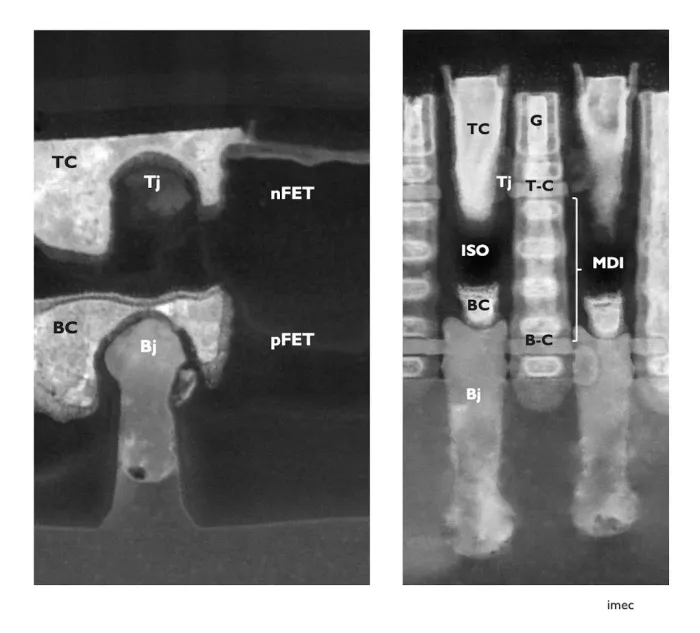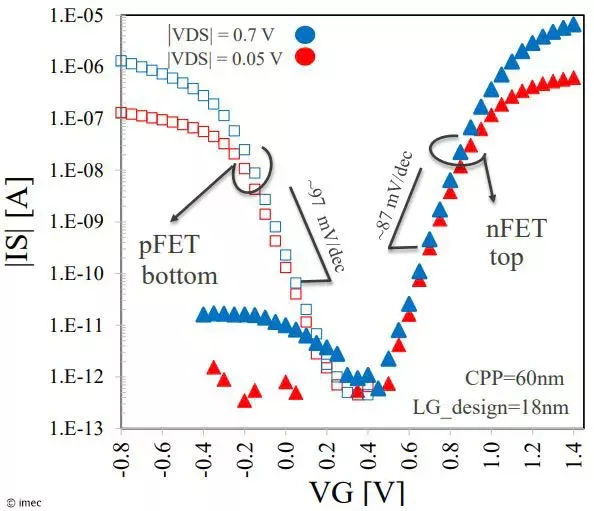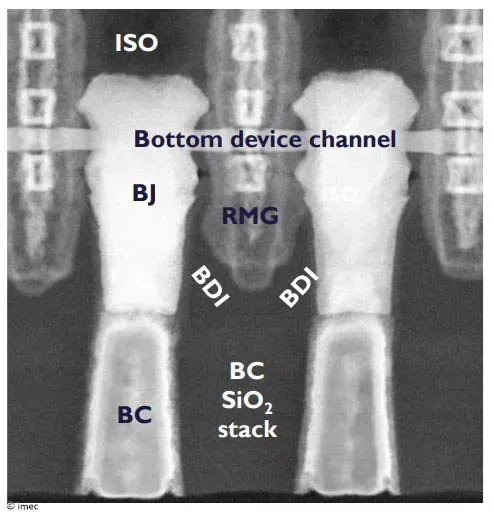Imec demonstrates functional monolithic CFET devices with stacked bottom and top contacts
LEUVEN (Belgium), JUNE 18, 2024— This week, at the 2024 IEEE Symposium on VLSI Technology & Circuits (2024 VLSI), imec, a world-leading research and innovation hub in nanoelectronics and digital technologies, presents for the first time electrically functional CMOS CFET devices with stacked bottom and top source/drain contacts. While the results were obtained with both contacts patterned from the frontside, imec also shows the feasibility of moving bottom contact formation to the wafer backside – significantly improving top device survival rate from 11% to 79%.
Imec’s logic technology roadmap envisions the introduction of complementary FETs (CFETs) in A7 node device architectures. When complemented with advanced routing techniques, CFETs promise to reduce standard cell track heights from 5T to 4T and even below, without performance degradation. Among the different approaches to integrate n- and pMOS vertically stacked structures, monolithic integration is considered the least disruptive compared to existing nanosheet-type process flows.
At the 2024 VLSI Symposium, imec demonstrates for the first time functional monolithic CMOS CFET devices with stacked top and bottom contacts. The CFETs were integrated at 18nm gate length, 60nm gate pitch and 50nm vertical separation between n and p devices. Electrical functionality was demonstrated on a test vehicle with nFET and pFET devices using a common gate, and top and bottom contacts connected from the frontside.
The proposed process flow includes two CFET-specific modules: the middle-dielectric isolation (MDI), and the stacked bottom and top contacts.
MDI is a module pioneered by imec to isolate top and bottom gate and differentiate on the threshold voltage settings between n and p devices. The MDI module is based on modifying the CFET ‘active’ multi-layer Si/SiGe stack and allows the co-integration of the inner spacer – a nanosheet-specific feature that isolates the gate from the source/drain. Naoto Horiguchi, Director CMOS device technology at imec: “We obtained the best results in terms of process control with an MDI-first approach, i.e., before source/drain recess – the step where nanosheets and MDI are ‘cleaved’ to gain access to the channel sidewalls and start source/drain epi. An innovative source/drain recess etch with ‘in-situ capping’ enables MDI-first by protecting the gate hardmask/gate spacer during the source/drain recess.”
A second critical module is the formation of stacked source/drain bottom and top contacts, vertically separated by dielectric isolation. Key steps are the bottom contact metal fill and etch back, and subsequent dielectric fill and etch back – all within the same tight space as available for the MDI stack.
Naoto Horiguchi: “When developing the bottom contacts from the frontside, we encountered multiple challenges, affecting bottom contact resistance and limiting the process window for top device source/drain formation. At 2024 VLSI, we show that it is feasible to move the bottom contact formation to the wafer backside, despite additional process steps linked to wafer bonding and thinning. The top device survival rate increased from 11% to 79%, making backside bottom contact formation an attractive option for industry. Research is currently ongoing to identify the optimal contact routing approach.”

Figure 1 – CMOS CFET devices with MDI and stacked frontside patterned contacts (TC = top contact; TJ = top junction; BC = bottom contact; BJ = bottom junction). SEM cross sections are shown along (left) and across (right) the BC/TC.

Figure 2 – Id/Vg curves for nFET and pFET with frontside patterned stacked contacts.

Figure 3 – SEM picture showing bottom contacts formed on the wafer backside and positioned accurately over the bottom junction formed on the frontside (BDI = bottom dielectric isolation).
About imec
Imec is a world-leading research and innovation center in nanoelectronics and digital technologies. Imec leverages its state-of-the-art R&D infrastructure and its team of more than 5,500 employees and top researchers, for R&D in advanced semiconductor and system scaling, silicon photonics, artificial intelligence, beyond 5G communications and sensing technologies, and in application domains such as health and life sciences, mobility, industry 4.0, agrofood, smart cities, sustainable energy, education, … Imec unites world-industry leaders across the semiconductor value chain, Flanders-based and international tech, pharma, medical and ICT companies, start-ups, and academia and knowledge centers. Imec is headquartered in Leuven (Belgium), and has research sites across Belgium, in the Netherlands and the USA, and representation in 3 continents. In 2023, imec's revenue (P&L) totaled 941 million euro.
Further information on imec can be found at www.imec-int.com.
Related Chiplet
- Interconnect Chiplet
- 12nm EURYTION RFK1 - UCIe SP based Ka-Ku Band Chiplet Transceiver
- Bridglets
- Automotive AI Accelerator
- Direct Chiplet Interface
Related News
- 2024 IEEE Electronic Components and Technology Conference to Spotlight Cutting-Edge Microelectronics Packaging Technologies; Photonic Devices, Heterogeneous Integration are Among Key Topics
- Top-Down Vs. Bottom-Up Chiplet Design
- Top 10 Foundries Experience 7.9% QoQ Growth in 3Q23, with a Continued Upward Trend Predicted for Q4
- Top Ten IC Design Houses Ride Wave of Seasonal Consumer Demand and Continued AI Boom to See 17.8% Increase in Quarterly Revenue in 3Q23
Latest News
- Rebellions and Red Hat Introduce Red Hat OpenShift AI Powered by Rebellions NPUs to Fuel Choice and Flexibility in Enterprise AI
- Arteris to Expand Portfolio with Acquisition of Cycuity, a Leader in Semiconductor Cybersecurity Assurance
- CEA-Leti & STMicroelectronics’ Paper at IEDM 2025 Demonstrates Path to Fully Monolithic Silicon RF Front-Ends with 3D Sequential Integration
- Qualcomm Acquires Ventana Micro Systems, Deepening RISC-V CPU Expertise
- Imec mitigates thermal bottleneck in 3D HBM-on-GPU architectures using a system-technology co-optimization approach